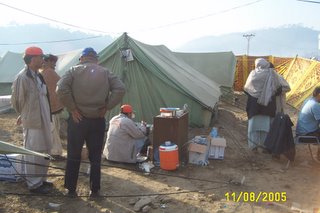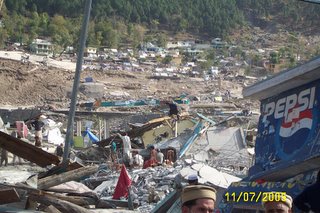
I have done village assessments in Upper Gurlot, Gunol, Kawai, Paras, Kot Bala, Sarwai and Bagah. However, today I can say Mission Accomplished, even though I have not made it to Kashmir yet.
The first two days were an introduction, writing out Need assessment coupons/chits to the needy. Next day we drove to Gunol, and I climbed 2000 ft to a village named Kalas in UC Kawai. I saw one tent for 22 households. Next we surveyed Paras, Kot Bala and Ghari Habib Ullah.
Yesterday, I went to Talhata Union Council. The emergence of a Sungi volunteer with an orange armband and Old Navy clothing draws people like flies. Their needs had been met, but we were surrounded by people who were hell bent on getting more tents. They tested my patience and I tore up two slips in anger. I am not blaming the local population, this is a natural effect in disasters, but being surrounded by angry villagers can lead even the best Samaritans astray.
However, as is usually the case the cunning political types end up escorting us. In Talhatta village my escort was particularly annoying. However, by now I had picked up on a few trick of the trades, which inspired some humiliation. A few thanked Allah and refused help. It is part of Sungi’s mission to locate local activist and grass root organizations. Most of the activists are mustachioed politicos trying to get their voting area assessed upfront. These we call de-activists. The preference is for community service members, teachers being foremost among them (someone should tell this to the Governator). One local teacher kept asking me to go to Sarwai in a Jeep. ‘The people are really needy in that area, no organization has reached them yet.’
So I took a treacherous ride in to the town of Sarwai squeezed next to Muhammed Ayub, the descendent of the local Pir, as Sarwai is the seat of a small shrine of Sien Muhammed. The village is at 5000 feet and has been decimated by landslides. Out of the 40 households I surveyed, there were 52 deaths. The population badgered, implored, threatened and begged me to help them. I wrote the necessary slips while my local guides provided protection and harmony. I only saw six tents in the entire village area that I surveyed, as I could not get to Upper Sarwai villages. On the way back, the Jeep ride turned ugly and I experienced real fear. It was at a hairpin turn, on the edge of a 2000 ft ravine, and the 1960's vintage purple Jeep CJ-7 could not turn so the driver had to reverse to the edge of the road to make the turn. At one moment, holding the handbrake with his hand and engaging the clutch with his feet in a Jeep occupied by eight men, he dropped the clutch and the car slid right to the edge, before he revved it up. During that time, instead of letting the newly married man do his job, the passengers started berating him for his bad driving. I think it was a Herculean effort to drive up that moluntain face for 1200 rs, $20.
Next day we left early in the morning to reach the furthest most villages in Talhatta union council. It has been 35 days since the 33-second earthquake hit and no one had climbed to these villages, as even the gravel Jeep road had been lost to flooding and landslides. Our jeep dropped us off on a dry riverbed filled with gravel, after the town of Sughdir. The area was known as Panch Chaki/five mills. However, now all we saw was a river of gravel, which was being loaded into tractors for construction. There is scree and gravel from the landslides. It is not an easy route and the temperature was hot. We crossed multiple frigid streams and climbed 3200 feet to the first hamlet and then split up. My friend Jawad went to Laspattiyan and I went to Bagah Sharif to conduct a house-to-house survey, and hand out relief slips. There were 45 households remaining in Laspattiyan (Elev 6247) and nearly 100 in Bagah Sahrif (Elev 6100), home to the shrine of Baba Faiz Mohammed. Both are the farthest village in the UC Talhata near the border of Azad Kashmir.
I nearly died from the climb. All the cigarettes that I have smoked were laughing inside my lungs. Now Jawad is a non-smoker, an athelte and a good squash player. My weekly exercise is chatting with my Sifu about Kung-Fu movies, so this was extremely hard. I heaved up with considerable efforts, as did my guide, he had being living in Saudi Arabia for the last eight year. There is a 3,000 ft assent from the Panch Chaki base and experienced trekking guides would describe the climb as extraneous. However, once I saw the beaming smiles of the old man who greeted us, it was worth it. As they say in Urdu, Mera bees kilo khoon bar gaya/I increased my blood by 20 kilos. The first group of houses belonged to carpenters who worked in Patel Para furniture market in Karachi. They had tied a red flag at the summit for passing helicopters. They showed me burst sacks of flour that had been dropped. No one had reached these hamlets before us, and they greeted us warmly, and served us tea and an egg dish. One of them had lost two children, 6 and 9, and his wife when his house collapsed. He had a serene smile, which conveyed much anguish. Entire mountain sections have been buried under landslides. While writing one slip sitting on top rubble, I asked for the owner’s father's name. He raised his hand in pryaers, and said, 'Lets pray, he is still buried under the rubble'.
I wrote 100 slip today, my first century and nearly all with tents as I saw only one tent in the entire village. Out of 200 households in Bagah, there have been 112 deaths, mostly children. The extent of damage is hard to capture with words, videos and pictures. Both jawad and I were determined to finish our assessments because nobody would be coming here for a while. However, in our zeal we forgot the time and it was nearly dusk when we started our descend. If the climb was risky, the descend was insane. Thank God for the Petra headlamps, which my brother jokingly suggested would be very useful to start the electric generator when the power goes out in my house. The sliding gravel, ravines and cooler temperatures made it risky. When we reached the Panch Chaki, our Sungi Jeep had left and we had to hitch rides on one of the tractors piled with gravel. However, both me and Jawad felt that we can go back, knowing fully well that we have done something.






